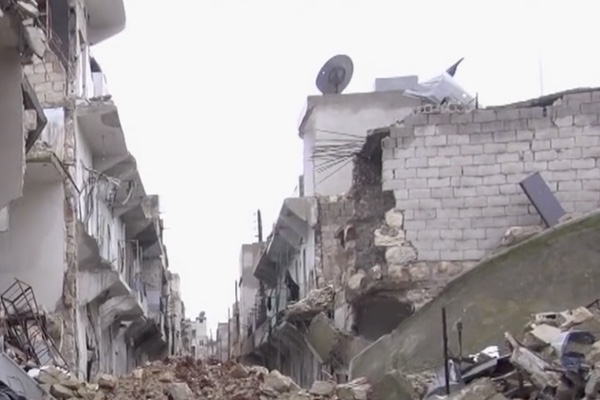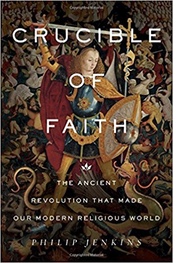Why What’s Happening in the Middle East Today Seems So Familiar to This Historian

Throughout the present century, the news from the Middle East has become steadily more chaotic and violent. Not long ago, states like Iraq and Syria were feared for their expansionism and their vicious internal repression, but at least they maintained some order within their territories. Those nations have now been shattered, in the face of rival nationalisms, the ideologies of religious sects, and of countless private armies and militias. Throughout, these conflicts have been manipulated by outside Great Powers. For an ancient historian, this whole process evokes a powerful sense of déjà vu, as it recalls events that were not just very similar, but which occurred in almost exactly the same geographical region. Some of the elements in that ancient story seem eerily similar, and so, perhaps, are some of the policy lessons.
 In 200 BCE, this
region formed part of a mighty empire that spanned the world from
Greece deep into India and Afghanistan. This realm took its name from
Seleucus, one of the generals of Alexander the Great, and it
reproduced the triumphs of that original conqueror. The imperial
capital was at the city of Seleucia-Ctesiphon, some twenty miles from
the center of modern Baghdad. At its height, this was among the most
populous cities on the planet, a worthy capital for a world-emperor.
Seleucid power in India allowed the empire to import war-elephants,
which in their time were the cutting-edge weapon that made its
military so fearsome. The empire left a rich cultural inheritance,
chiefly in scientific fields, as it encouraged the
cross-fertilization of Greek and Babylonian thought.
In 200 BCE, this
region formed part of a mighty empire that spanned the world from
Greece deep into India and Afghanistan. This realm took its name from
Seleucus, one of the generals of Alexander the Great, and it
reproduced the triumphs of that original conqueror. The imperial
capital was at the city of Seleucia-Ctesiphon, some twenty miles from
the center of modern Baghdad. At its height, this was among the most
populous cities on the planet, a worthy capital for a world-emperor.
Seleucid power in India allowed the empire to import war-elephants,
which in their time were the cutting-edge weapon that made its
military so fearsome. The empire left a rich cultural inheritance,
chiefly in scientific fields, as it encouraged the
cross-fertilization of Greek and Babylonian thought.
The empire reached new heights under Antiochus III, the Great (222-187). But like the modern-day tyrant Saddam Hussein, Antiochus made the deadly mistake of challenging another world power, in that case, the Roman Empire, which was developing radical new military tactics and weaponry. The Romans crushed Antiochus militarily in 190 BCE, at the epochal battle of Magnesia. The Romans could not feasibly hope to occupy the whole Seleucid realm, but they could demand eye-watering financial reparations, and moreover insist that Antiochus observed strict arms control: the elephants had to be lamed, under outside supervision. Whatever they might do, the Seleucids always knew that the Romans were watching, and seeking new opportunities to invade.
The Seleucids were both humiliated, and ruined financially, driving them to ever more risky and desperate military adventures. That began an era of crisis and fragmentation, as nations, ethnic groups and religions long suppressed by the Seleucids bid for independence. First to go were border kingdoms uneasily attached to the larger empire, but the rot soon spread to what had been heartland territories. Some of these successor states – like Armenia and Pontus – enjoyed real power, and briefly became empires in their own right. By far the greatest beneficiary of the Seleucid collapse was the Parthian kingdom, in modern Iran. In 141 BCE, the Parthians seized the Seleucid capital, confining the later kings of the dynasty to what we would today call Syria.
Constant pressure from outside powers - Rome, Parthia, Egypt, and Pergamon - ensured that the Seleucids could never find an opportunity to pause and rebuild. Apart from direct invasion, those external enemies regularly supported factions and kingdoms within the Seleucid realm, fuelling unrest and secession.
Beyond the simple lust for power, the various contenders had an enormous economic motive to seize and divide Seleucid lands. By uniting the Mediterranean world with Central Asia, the Greek conquerors had powerfully developed the trade of the Silk Road, the conduit not just for textiles but for the hugely profitable traffic in spices. Then as now, greed for priceless raw materials drove political aggression and interference.
But some of the region’s players had other non-material motives for resisting the Seleucids. In the region of Palestine, powerful Jewish factions developed religious-nationalist ideas, which in the 160s provoked open revolt against Antiochus IV, son and heir of Antiochus the Great. As the struggle expanded, and the wars degenerated into still greater bloodshed, revolutionary ideas became increasingly apocalyptic and messianic in tone. The great literary monument to this crisis is the central portion of the Biblical Book of Daniel, written in 165 BCE, which later generations have constantly mined as the foundation text for apocalyptic thought. Later Christian concepts of the Antichrist or of diabolical rulers adopted Daniel’s vision, with its vicious portrait of a thinly disguised Antiochus IV destroyed and humbled by a messianic leader. By the 130s a restored Jewish kingdom joined the roll-call of new states erected on the ruins of the Seleucid world.
Seleucid power contracted steadily until by the end of the second century BCE, little was left. The patchwork map of the successor statelets and petty kingdoms looks remarkably like a political picture of modern-day post-Ba’thist Syria and Iraq. By the 80s BCE, a grandly named ruler like Antiochus XII Dionysus exercised little power beyond Damascus and its immediate environs. After some years of success, most of the new post-Seleucid states and empires crumbled in their turn, leaving only two real victors, namely the great world empires of the West and the East – of Rome, and Persia. In the 60s BCE, the Roman general Pompey was at war with Armenia and Parthia, and almost as an afterthought, he annexed the pathetic remnants of the Seleucid empire into what became a new Roman province of Syria. Meanwhile, Seleucia-Ctesiphon remained the capital of Parthia and of later Persian empires for a thousand years, until it was in turn replaced by Baghdad.
In terms of its lasting influence, the empire had more impact in its dissolution than in its heyday. Ultimately, the patchwork map of small states was likely to be temporary, lasting only until one big fish chose to swallow its small neighbors, and in retrospect, we know that the victor would be Persia. Given Iranian influence across the region today, that precedent inevitably sounds disturbing.
Yet that new imperial structure could not entirely eliminate the millenarian and apocalyptic hopes and fears that had been stirred in the years of chaos, and which have exercised so potent an influence on Jews and Christians, and an influence for good. In the desperate conditions of the modern Middle East, apocalyptic ideas have driven radical Islamist activism, including that of the Islamic State. We can only hope that, as the Caliphate is crushed, those religious ideas do not spread and metastasize further afield.